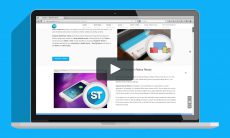How much content have you created and curated for your business in the past twelve months? If you’re like most companies, you’ve dedicated a significant chunk of time and money into developing content designed to attract attention and drive sales. And, in theory, it should work. After all, data from the Content Marketing Institute says, dollar for dollar, content marketing generates three times as many leads as paid search.
So, why aren’t you seeing similar results for your business? Why isn’t your content converting customers and driving sales? What’s missing?
You may want to explore these simple steps designed to help your content convert.
If you want your content that converts for your business, follow these simple steps:
- Lead with your most important information
- Highlight customer benefits
- Test your calls-to-action (CTA’s)
- Write simply
- Monitor your bounce rates
Let’s examine each of these in detail.
Lead With Your Most Important Information. Your content rarely exists for its own sake. No offense, but you’re not Ernest Hemingway, Stephen King, or JK Rowling. Customers visit your site and engage with your content not because it’s brilliant content in its own right, but because they’ve got something they need to get done. Your content must help customers accomplish their goals. So, why would you bury the most important details behind walls of jargon or flowery prose?
Help customers find the information they need, help them understand how that information helps, present them a call-to-action (CTA) that asks for the sale (or the appropriate next step in their journey), and let them get on with their day. One recent client saw a significant increase in conversion rate by streamlining content on their key landing pages to focus solely on answering customer questions. A simple set of changes drove measurable improvement in conversion rate, leads, and sales. Why not look at the same for your business?
Highlight Customer Benefits. Do you know what WIIFM means? It means “What’s in it for me?” And it’s the mantra your customers live by. As already mentioned, your customers are busy folks. Don’t make them guess why and how they might benefit from your offerings. And don’t lead with an endless list of features.
Give customers clear, simple benefit statements to help them understand why those features matter. Yes, you have to provide necessary details. But place those details further down the page or behind a “Learn more” link. Start with how your customers stand to gain from the features you offer instead and watch your sales soar.
Test Calls-to-Action. This might seem silly, but it’s amazing how many landing pages I see that don’t make it clear what I’m supposed to do after engaging with their content. Do you want customers to download a white paper? Subscribe to emails? Add a product to their cart? Contact a salesperson? What do you want them to do? Don’t make your customers guess.
Test placing a single, simple call-to-action after each set of benefit statements to increase clickthrough and conversion. And test different CTA placements, colors, and copy so you can learn what works best for your customers and drives conversion rate from within your content. In one case, one client was able to increase conversion rate by over 35% in less than six months by testing different placements and format for their calls-to-action. It’s amazing how simple changes to the way you ask for the sale can effect your ability to get the answer you’re looking for.
Write Simply. Salesforce.com CEO Marc Benioff has said that “…speed is the new currency of business.” Google places huge value on your web page’s speed to determine search rankings. Shouldn’t we similarly place huge value on the amount of time it takes customers to understand our content? According to Wikipedia, “…the ‘average’ American reads at a 7th or 8th grade level.” Given how busy your customers are today, why would you slow them down and make them work so hard to understand what it is you have to say?
Focus on making your content simple to view, read, and understand. Work to keep your content at or around the 8th grade reading level (this post clocks in at 7.6 according to a Flesch-Kincaid analysis, if you’re interested). Easier text correlates highly with lower bounce rates and increased engagement with your CTA’s. Don’t make your customers work so hard to choose you — or to even understand why they should. Make it easy for customer to understand what you have to offer and you’ll be pleasantly surprised by how easy you make it for them to convert too.
Monitor Your Bounce Rates. It likely comes as no surprise, but bounce rates tend to move in the opposite direction from conversion rates. Which makes sense if you think about it; no one who leaves after viewing just page is ever likely to convert. But too few companies pay enough attention to bounce rate, especially when segmented by channel, landing page, or site functionality (such as site search). Why would you ignore such an important canary in the coal mine for your business?
Happily, most of the tips on how to have your content drive conversion covered in this post help drive down bounce rate too. But pay attention to the relationship between these metrics for your content and work to continually improve both bounce rate and conversion for your business.
Conclusion
Companies invest huge sums of money into creating content for their customers, but often with little insight into whether it produces value for the company or the customer. Don’t be “that guy.” Make sure your content places your most important information front and center for your customers. Highlight the benefits they’ll receive simply and clearly. Test your calls-to-action regularly. Write simply, always. And continue to pay attention to your bounce rates for the signals they offer about where your conversion rate is heading.
Creating content that converts is part science and part art. But the practice of continually improving is all about process. It’s about using available data to understand what’s working, what’s not, and how to fix what’s broken. And the lesson we keep learning is that you want to make it easy for customers to understand who are you are, how you can help them, and what they need to do next if they’re interested in having you help. Focus your efforts around making that process as painless as possible for customers and you won’t be asking “How do we make our content convert?” You’ll be asking, “How can we keep up with all this demand?”
Want to learn more about how to make your content convert? Drop my friends at SoloSegment a line to help you improve your content — and your conversion.




